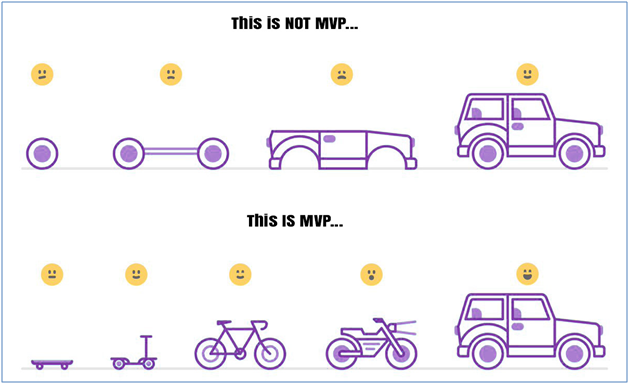When you launch a product in the market, the product goes through four important phases, i.e. it’s a hit or a flop, or consumers slowly accepted/rejected it. If your product is an instant hit in the market, you are the lucky one and if not, it’s a big business blunder.
So, how can you save yourself from such big business blunders? 
What is an MVP?
The Minimum Viable Product (MVP) method can save you from committing such business blunders. Development of MVP is a common IT practice today.
An MVP is a product development method that focuses on building a workable product with minimum features for the early users and they provide feedback for future product development.
Getting insights from MVP is less expensive than blindly developing a full-fledged product since the later increase costs and risks in case of failures! The below-mentioned infographic describes the difference between an MVP empowered, and non-MVP approaches.
Image Courtesy: x-staticmediagroup.com
Ideally, an MVP features the core characteristics that are sufficient to deploy the product (software/application). Typically, the developers deploy an MVP product to a predefined group of possible customers/users who are interested in giving feedback and understand the product vision from an early prototype or marketing information. This strategy targets in avoiding building products that are not customer-friendly and it requires assessments to figure out for any given context where an MVP approach makes deep sense.
An MVP can be a successful product building strategy. Moreover, it is a core artifact in an iterative process of idea generation, prototyping, presentation, data collection, analysis & learning, adapting and improving. One seeks to minimize the total time spent on iteration.
Following are the seven primary and key aspects one should consider while defining the scope of an MVP.
1. Identify the Target Audience:
Identifying the right group of the target audience is the most essential strategy of a business. First, you need to get answers to the following questions to identify the target audience.
- Target Audience: For whom you are developing the app?
- Target Market/Region and interests of people: Is there a specific market/region you are targeting? What do those people have in common? (Demographics, motivations, values, etc.)
2. Identify the budget and deadline/timeline for launching:
It is quite important to launch the MVP at the right time considering the increasing competitions and changing business needs & user demands. Hence, if MVP is not released at the right time, the included features can reduce the values. At the same time, one should also consider that the MVP features could be accommodated within the budget.
3. Identify the most valuable features in the end users perspective:
The features, which are considered for MVP should be valuable to the end user. You can identify those features by finding answers to the following questions:
- What are the pain points or problems the target audience is experiencing?
- Which features can be developed to resolve the pain points?
- Why would they want the features to be developed? Isn’t there an alternative solution available in the market with the specified features? If yes, why that feature is not useful or what is missing in the existing solution?
4. Implement as per current trends but keep the things simple:
The MVP should be built considering the latest trends of the particular industry. However, the simple design supports users to understand and start quickly.
It’s quite important to keep pace with the changing market needs and an ideal way to do so is to keep a track of the current trends. There are continuous changes in UI/UX standards these days, and one of the classic examples are mobile applications. Earlier, you must have seen the curved graphics in most of the applications, which are completely replaced by flat controls and material design standards. Apart from this, raster graphics are being out of trend and vector graphics are used widely as per the current trends.
E.g., earlier you used to see ‘Form’ based login in most of the websites and applications wherein user had to provide the username and password and hit the Login button to enter the system. However, now, you will see most of the application enables quick access to the system by using users’ existing Google, Facebook, Twitter and Instagram accounts! With this, users don’t need to go through the lengthy registration process.
You would have even seen most of the applications, providing OTP based login wherein user needs to provide only the mobile number and the OTP will be directly sent to the provided number, this ensures security as well as simplicity.
On top of this, you must have seen mobile applications, which detect the mobile numbers on the devices automatically and allow a user to choose even from multiple numbers (in case of dual sim mobiles) and OTP will be sent to the selected number. In addition, the application nowadays also reads the received OTP automatically and logs a user in the application.
Overall, the core part of adopting new trends is to assure an easy user experience (UX).
5. Attract the end users to use the system as well as invite others:
We should implement functionalities that can bring more user registrations. Having referral programs to start with is a good example of spreading the product.
With the diversified user demands, it is also wise to keep track of your competitors and their products and keep analyzing their performance. It gives ideas on what is missing there or what you can do better to attract more users over your competitors.
6. Save end users’ details for future releases:
Make sure that you save the user details, which will give data points for future implementation. Further, having analytics of how users interact with the built system and what is the most attractive feature for the user would be a good data point for launching future releases. Therefore, the idea is to have data points to build, measure, learn, and evolve with a smart approach.
If you want to know more about how analytics helps the business to increase the user base and help grow your business, then refer here.
7. Use the pre-launch page and market the product:
Spreading the news about the product to the maximum end users is quite important and pre-launch is a key to it. Having referral programs and social media platforms integrated as a feature is also a good way to do this. In addition, pre-launch is like a pilot program which gives a glimpse of the struggles of the products/services in the potential market.
Balancing Technical & Business Needs
Minimum Viable Product is a key factor in agile project management. It boosts up an iterative development process, which inspires releasing a rough version of the product with the motive of getting feedback. Each cycle of such process advocates the development of the products with better & feasible features.
Overall, MVP stands as a pure gold strategy for the small & medium entrepreneurs including the startups. MVP reinforces the flexible working method of a business firm. In this digital age, all type of companies from startup to large-sized, it is crucial to get feedback from the early users with the releasing of a tentative product. The MVP approach not only saves cost and efforts but also revitalizes the conventional product development approach with a real-working method that helps products to bloom from a baby to a matured individual.






